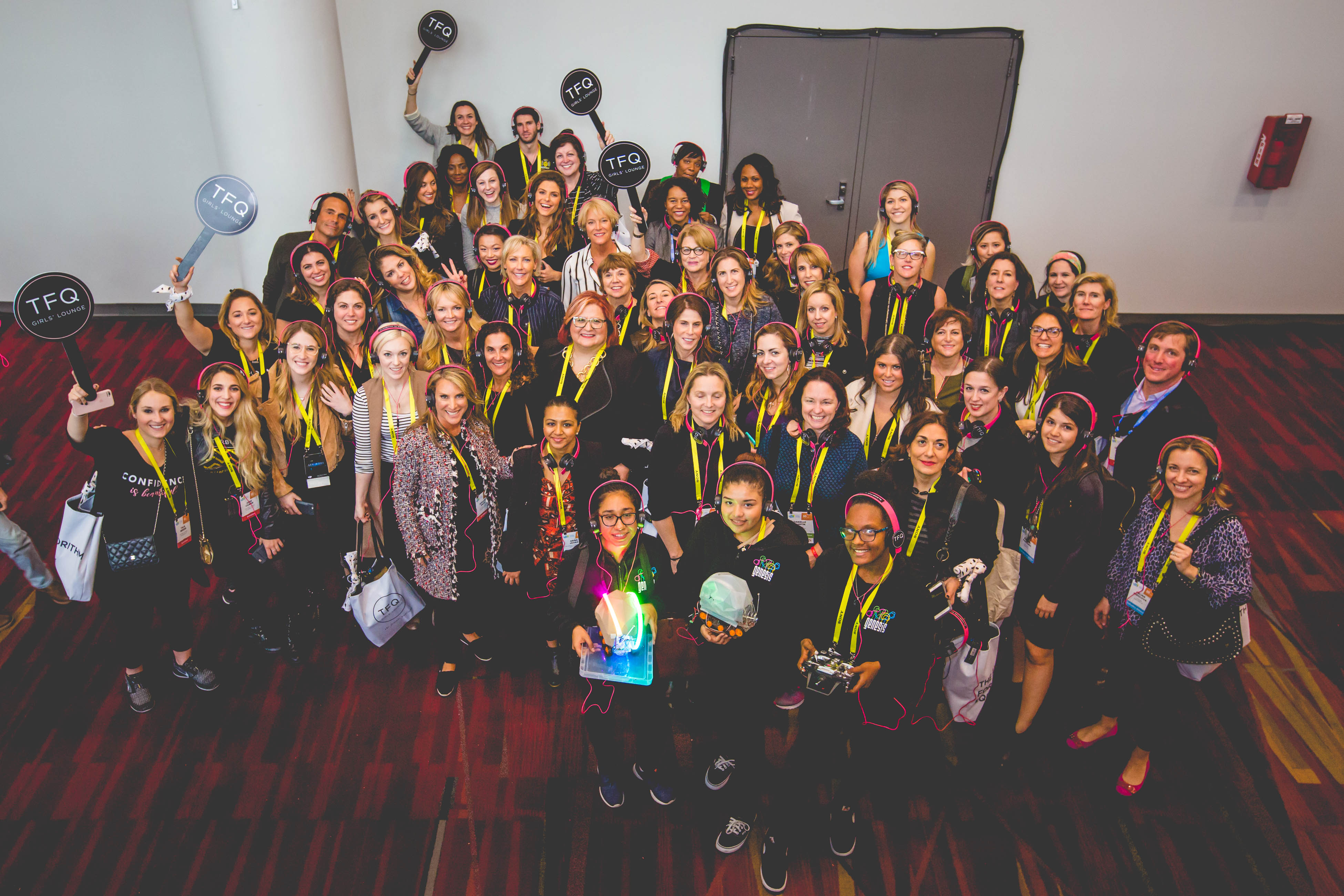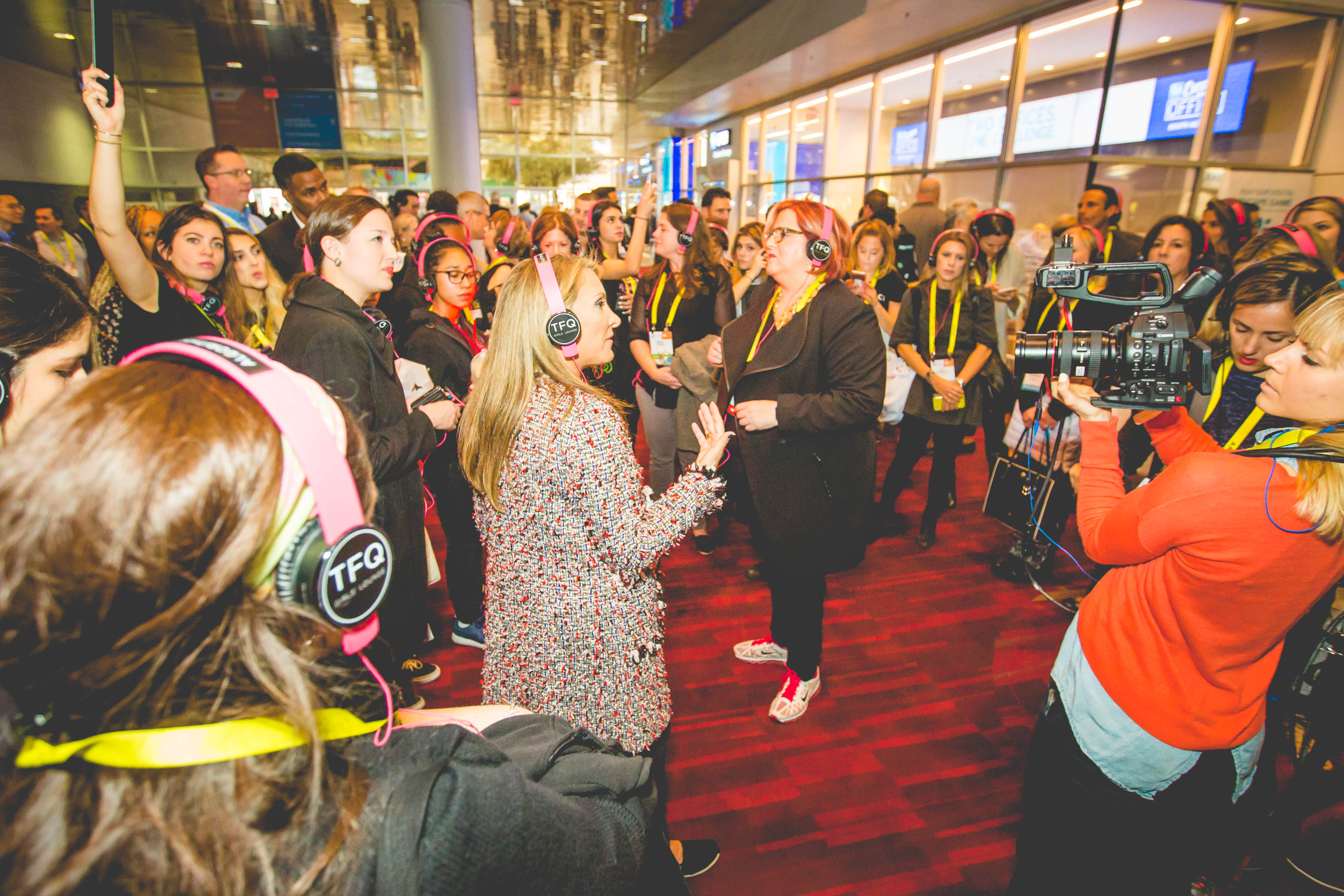Female Quotient Illustrates "Power of the Pack" at CES

Last week at CES, amidst a bustling show floor a thousand techies deep, The Female Quotient, founded and led by Shelley Zalis, made its presence known. Over a hundred women clad in pink headphones and black TOMS, with roles ranging from CMO to advertising executive to reporter to STEM student, broke through the sea of convention khakis to diversify the floor. Together we proved there is power in the pack.
The Girls' Lounge, powered by The Female Quotient, has become the go-to destination at conferences for women to connect, collaborate and activate change. This community of women supports and mentors each other to find our individual voices, embrace feminine leadership qualities and work together to transform corporate culture. When your group is choc' full of creatives, ad pros and entrepreneurs, change happens.
Joanna Peña-Bickley, Global Chief Creative Officer, IBM iX (pictured below center, facing left) and one of our change-makers, joined Dana Wollman, Managing Editor at Engadget in directing our mini-mob through the frenzied CES halls, providing insight into the products that will revolutionize the advertising industry over the next few years. Heads not only turned because of the pink headphones, but also because an impressive bunch of women were huddled together discussing the impact of autonomous vehicles, connected umbrellas, hands-free breast pumps and talking refrigerators!

"The best advertising we can deliver is a service for consumers, and this will happen by integrating advertising into consumer products in an organic manner," Joanna shared. "If your fridge can help you plan dinner and say, 'Hey, here are three ingredients that are about to expire, and here's a coupon code for pasta' … that's how you provide 365 days of relevance."
She continued, "The idea is not to compete with tech companies, but to integrate with them, so consumers buy your products. The auto industry will not only continue to make money by selling cars, but now they can sell impressions and time spent in the vehicle, too. We're talking about full-on IOT (Internet of Things), the integration of Watson baked into a car, Alexa integrated into Samsung devices. Hardware is a commodity, [but] people aren't looking at the hardware, they're looking at what the software can deliver. And that's where you deliver marketplaces. We are designing time for brands now. That's the new advertising. What moments are you going to own, and what's the device that makes sense?"
Maybe it's just me, but I feel anxiety when I start to think about all my smart devices and having my home lighting connected to an app on my phone … and what if my phone goes dead and then I can't turn the lights on/off? Lately I've been confusing Siri with Alexa -- she's not too happy with me!
It all boils down to a change in consumer behavior. Just look at how "swiping" has become the norm. It was actually mobile that brought on that change in behavior and that changed web site design from multi-tabs to endless scrolls.
Joanna, a designer at heart, said that when starting a project she looks at the human condition and asks what are their unmet needs. "Now that mobile phones have met the minimum expectations and have set the bar, what are the devices I want to invite into my home and life that are going to help me save time?" she asked.
I have to be honest, that washer and dryer that folds clothes and does dry-cleaning right in your own closet -- yep, that's on my wish list. I heard Shaq bought four on the spot!
Technology that helps Joanna stay connected to her "four radically different children in a way that isn't invasive" is key. There is now a "family map" using the same technology behind Uber and Lyft, so you can see when your hubby is close to arriving home. This would be perfect for me; I could shut off Netflix and pretend I didn't cheat/binge-watch without him.
The next evolution in the tech space will be well versed in how to utilize natural language and the way we speak with machines so that they can anticipate what we need, knowing our intent. Right now Siri and Alexa have no clue. If you want to crack into the world of machine design, study natural language. Joanna left us with this nugget: "User experience (UX) is no longer a design strategy; it's a business strategy." Think about that one, ad folks.
We ended our floor tour on a high at the footprint activation for the recently released motion picture, Hidden Figures.The interactive display showcased the true and mostly unknown story (until now) of three brilliant African-American women at NASA, Katherine Johnson and her colleagues Dorothy Vaughan and Mary Jackson, who served as the brains behind one of the greatest operations in history -- the launch of astronaut John Glenn into orbit. Inspired, the ladies of the Girls' Lounge vowed to make more of our stories known and to keep changing the game.
The Girls' Lounge at CES was supported by Clear Channel Outdoor, Aol, Visa, Twitter, Facebook, NBCUniversal, Unilever, Google, IBM iX, Ipsos, IPG, L'Oréal, Viacom, PepsiCo, Turner, PopSugar, Makers, MediaLink, The New York Times, Kargo, Bloomberg, Yahoo, Clique Media Group, Spotify and Magnetic Collaborative.
Visit The Female Quotientto learn more.
Click the social buttons above or below to share this story with your friends and colleagues.
Photo credit: Stacey Salter Moore. The opinions and points of view expressed in this article are exclusively the views of the author and/or subject(s) and do not necessarily represent the views of MediaVillage.com/MyersBizNet, Inc. management or associated bloggers.


